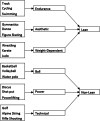Prevalence of disordered eating in athletes categorized by emphasis on leanness and activity type - a systematic review
- PMID: 33005418
- PMCID: PMC7523350
- DOI: 10.1186/s40337-020-00323-2
Prevalence of disordered eating in athletes categorized by emphasis on leanness and activity type - a systematic review
Abstract
Background: Disordered Eating (DE) shows a strong association with athletics and can lead to several negative mental and physical health effects. Traditionally, sports have been grouped based upon whether or not the sport emphasizes leanness as a competing factor. Due to sociocultural factors, risk for DE may also be associated with the sport type. The aim of this review is to critically analyze the available research and data in this field to consider the relationship between DE and sport type to see which factors influence prevalence among athletes.
Method: A systematic review was completed using keywords specific to DE and sport types. Articles were either excluded due to lack of specification of athlete type or failure to use a standardized screening tool or interview for data collection.
Results: 6 out of 7 studies found a significant increase in DE rates among lean sport types. When classifying by sport type reports were less consistent, but show non-lean sports also have increased rates of DE.
Conclusion: There are variations in prevalence of DE behaviors depending on athlete type. It is important to identify the risk for DE early in athletes so emphasis can be placed on treatment options to nullify progression to an eating disorder, lower negative impacts on an athlete's performance, and prevent other negative health effects. Using sport groups is important to clinical practice as well as research, as certain sports may have a higher risk for development of DE.
Keywords: Activity group; Disordered eating; Eating disorders; Leanness; Sport group; Sports mental health.
© The Author(s) 2020.
Conflict of interest statement
Competing interestsThe authors declare that they have no competing financial interests.
Figures
References
-
- Thompson RA, Sherman RT. Eating disorders in sport. New York: Routledge; 2010.
-
- Wilson D, O’Connor EL. Mindfulness, personality and disordered eating. Personal Individ Differ. 2017;119:7–12. doi: 10.1016/j.paid.2017.06.033. - DOI
Publication types
LinkOut - more resources
Full Text Sources



